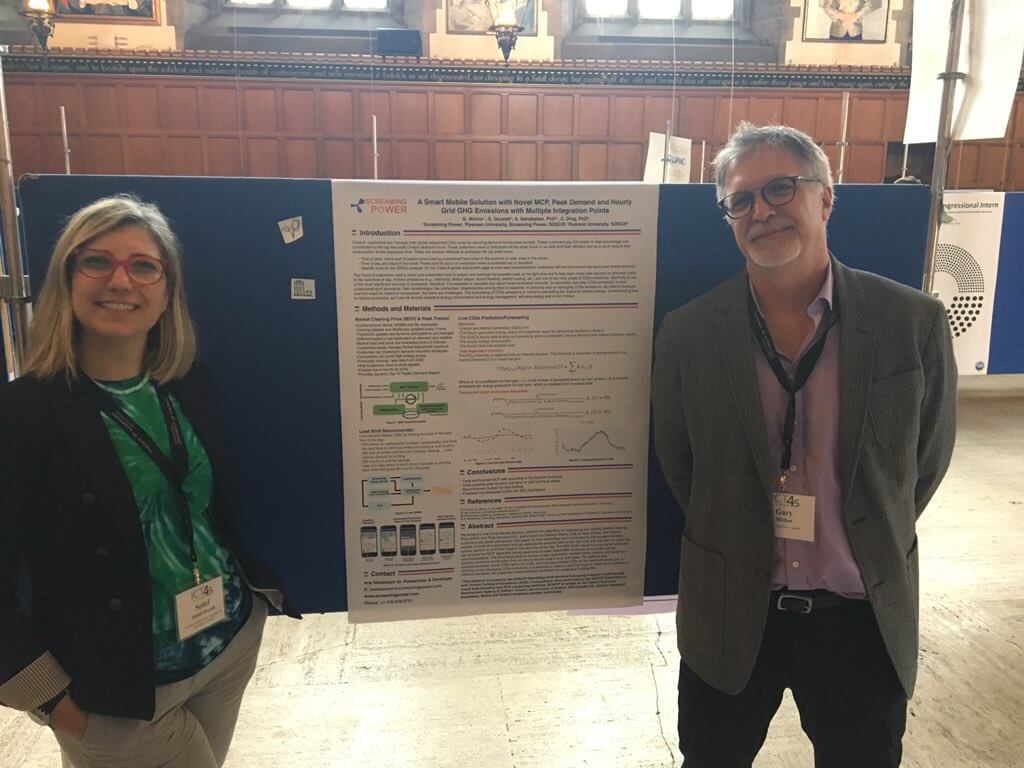Case Study
A Smart Mobile Solution with Novel MCP, Peak Demand and Hourly Grid Emissions with Multiple Integration Points
G.Michor1; G.Doucett1; A.Sahebalam, PhD2 ; C.Ding, PhD3
1Screaming Power, 2Ryerson University, Screaming Power, SOSCIP, 3Ryerson University, SOSCIP
A Smart Mobile Solution with Novel MCP, Peak Demand and Hourly Grid Emissions with Multiple Integration Points
Introduction
Class-A customers can manage their Global Adjustment (GA) costs by reducing demand during peak periods. These customers pay GA based on their percentage and contribution to the top five peak Ontario demand hours. These customers need to anticipate the top peak hours to be able shift their demand and as a result reduce their consumption at the opportune time.

There are several methods to anticipate the top peak hours:
• Time of year: Some part of peaks occurs during a sustained heat wave in the summer or cold snap in the winter.
• Time of day and days of the week: Peaks tend to occur on weekdays when businesses are in operation
• Specific tools on the IESO’s website: On the Class-A global adjustment page at www.ieso.ca/peaktracker, customers will find the current day and week-ahead demand.
The Class-A customers need a smart and automated tools to predict and estimate the possible peak at the right time and to help them make best decision to shift their loads to the best time of day. Indirect emissions (e.g., electricity, district steam, district heating, district cooling, etc.) are one of the main areas of CO2e emissions. Electricity is one of the most significant sources of emissions; therefore, it is essential to calculate and report these emissions correctly. To accurately calculate CO2e emissions, a clear understanding of standards, their relationships, the similarities / dissimilarities among them is essential. In reducing and–or managing CO2e emissions, we need to measure and find ways for objective comparison, but there are challenges. The forecasting of CO2e emissions is critical in preventing the impact of climate change. Understanding how to reduce emissions, as it can be directly related to energy conservation and energy management, will save energy and in turn money.
Methods and Materials
The published paper can be found at Energy Science & Engineering Journal via https://onlinelibrary.wiley.com/share/YRV5ABR79PSCG49VIGZE?target=10.1002/ese3.272. Screaming Power’s continued work on this topic will be presented in the coming months after 2 years of research on weather normalization and Cognitive Conservation. This innovative intelligence algorithm and method is patent pending and applied in Screaming Power’s business tools for Energy Utilities and large enterprise customers wishing to discover better ways to manage, analyze and forecast energy costs today and in the future.
Screaming Power wants to thank Dr. Soosan Beheshti, Dr. Asad Sahebalam and Edward Nidoy for their hard work and commitment to helping make energy management more accurate in the changing weather landscape.
For more information on this paper and continued work, contact Screaming Power at wanttoknow@screamingpower.com

About Screaming Power Inc.
Screaming Power is revolutionizing customer engagement by providing a mobile platform that connects the energy user, allowing for effective and secure two-way communications to educate, change behaviour and encourage sustainability. Our extensible Intellectual Property provides a low-cost, digital infrastructure for a self-sustaining Eco-System. Our Scream Utility & Scream Enterprise mobile solutions focus on reducing ‘cost-to-service’ for utilities while driving satisfaction and facilitating the delivery of innovation (e.g., connectivity to the IoTs).
About Ryerson
Ryerson University is Canada’s leader in innovative, career-oriented education. Urban, culturally diverse and inclusive, the university is home to more than 45,300 students, including 2,600 Master’s and PhD students, 3,800 faculty and staff, and nearly 198,000 alumni worldwide For more information visit ryerson website.
